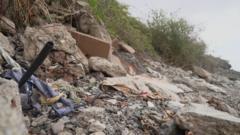Cows wading through flood water, a coral glowing like a Christmas tree and an insect food experiment were among the breathtaking winning entries from the Environmental Photographer of the Year awards have been revealed.
The annual competition showcases environmental photography from all over the world to inspire climate action.
This year's six winners include amateur and professional photographers aged 17 to 70 from some of the world's most climate vulnerable countries like Bangladesh, India, and Argentina.
Thousands of pictures from over 159 countries were submitted for the prize by CIWEM and WaterBear, which encourages photographers to use photography as a tool to generate awareness for climate change.
The competition, which has been running for ts 16th year, has six categories: Environmental Photographer of the Year, Nikon's Young Photographer of the Year, MPB Vision of the Future, Recovering Nature, Keeping 1.5 Alive and Adapting for Tomorrow.
WINNER: The 2023 grand title winner is Maurizio di Pietro, a professional photographer based in Italy, who was recognised for his photo of an innovative insect food experiment at the University of Turin (pictured)
WINNER: The prize for Nikon's Young Environmental Photographer of the Year (21 and under) went to 18-year-old Solayman Hossain for his picture showing a farmer and his cows forced to wade through floodwater to find food, after the road became submerged in water (pictured)
SHORTLIST: Beyond The World by Aniruddha Pal, who was the runner up in the Adapting for Tomorrow category. The photographer has been taking photos of this region for the last 4-5 years. Every year when the water is low and/or moving slowly, a photochemical reaction creates a moss-like structure (pictured)
The 2023 grand title winner is Maurizio di Pietro, a professional photographer based in Italy, who was recognised for his photo of an innovative insect food experiment at the University of Turin.
Led by Professor Laura Gasco, the research project assesses the impact of incorporating insect flour into the diets of rainbow trout and chickens to determine its potential as a nutrition source, particularly as food scarcity increases in line with a growing population.
The Hermetia illucens, or soldier fly, is rich in proteins and a highly sustainable food source, thanks to its minimal water and soil consumption. By feeding on food waste, these insects also contribute to a circular economy.
The photo is part of the photographer's 'Zero Hunger' series, documenting worldwide food insecurity and the solution presented by insects.
Mr di Pietro said: 'My home country of Italy is experiencing a frightening reality: 22% now face food insecurity, and this number is only set to increase as climate change intensifies.
'Through my photographs, however, I don't just want to document the problem, but also offer away forward.
'By photographing experiments of potential new food sources, I hope to break open the closed corridors of academia and raise awareness of this solution around the world.
'Only by showing a way forward can we inspire people to abandon a doom-drenched view of the world and fight for a better one.'
The prize for Nikon's Young Environmental Photographer of the Year (21 and under) went to 18-year-old Solayman Hossain for his picture showing a farmer and his cows forced to wade through floodwater to find food, after the road became submerged in water.
The photo was taken during monsoon season in Kushtia, Bangladesh, in a village close to Mr Hossain's own.
He said: 'I hope my photo will inspire environmental action by showcasing the importance of nature, raising awareness about environmental issues, and encouraging others to take positive steps towards sustainability.'
In the 'MPB Vision of the Future' category, Jahid Apu, professional photographer from Bangladesh, was chosen as the winner for his photo of a bridge surrounded by a sea of plastic waste, entitled 'A Walk Through Trash'.
WINNER: In the 'MPB Vision of the Future' category, Jahid Apu, professional photographer from Bangladesh, was chosen as the winner for his photo of a bridge surrounded by a sea of plastic waste, entitled 'A Walk Through Trash' (pictured)
WINNER: Nicolas Marin, 24, took home the prize in the 'Recovering Nature' category. He is a photographer based in Argentina, scooped a category win for his photo of a rare luminescent coral (pictured)
Bangladesh is one of the top plastic polluted countries, with about 646 tons of plastic collected daily in Dhaka.
Mr Apu said: 'Whenever I walk over this bridge, I always wonder how we can survive with so much plastic. Children are often playing in the garbage, with nearby communities forced to live around this sea of waste.
'I want my photo to be a wake-up call, encouraging people around the world to put an end to plastic pollution once and for all. My home country of Bangladesh has been hit especially hard by climate change.
'As the crisis intensifies, photographers must abandon pretty nature pictures for ones that confront our changing planet and inspire us to protect it.'
Nicolas Marin, 24, took home the prize in the 'Recovering Nature' category. He is a photographer, National Geographic underwater explorer, environmental activist and former professional tennis player based in Argentina, scooped a category win for his photo of a rare luminescent coral.
The photo was taken during a night dive in Aruba using a long-exposure technique and an ultraviolet light source.
SHORTLIST: Work In The Red Dust Of A Brick Kiln by Kamol Das was shortlisted in the Adapting for Tomorrow category. It shows contractual labourers who work 9-10 hours/day in the brick kilns during the dry season
SHORTLIST: Crossing The Riverbed by Ahsanul Haque Nayem was shortlisted in MPB Vision of the Future category. The Jamuna river in the Bogura district dries up completely every year, but during the rainy season it is flooded again. When the river is dry, horse carts are the only means of transportation for the people of the Char
Documenting and protecting the oceans is a cause close to Mr Martin's heart, as he encounters fishing nets, straws and endless floating garbage while diving.
He said: 'We used specialised dive lights that wouldn't disturb marine life, and in the darkness, you could only see where the lights were pointed. On this occasion, I witnessed something I had never seen before: a coral glowing like a Christmas tree.
'This photo is important because it showcases the wonder and fragility of marine life and the need to protect it. Bioluminescence is a fascinating natural phenomenon that indicates the health of the ocean.
'Coral, as one of the foundational pillars of these ecosystems, faces significant challenges due to climate change, pollution, and habitat degradation.
'While there are challenges, there are also solutions underway, such as promoting sustainable fishing practices, establishing marine protected areas, and undertaking efforts to mitigate climate change. For me, corals are hope.'
The 'Adapting for Tomorrow' prize went to photographer and teacher Anirban Dutta, from West Bengal, who secured the win for his multi-exposure image of a cunning drongo using light from an urban petrol pump to catch termites.
WINNER: The 'Adapting for Tomorrow' prize went to photographer and teacher Anirban Dutta, from West Bengal, who secured the win for his multi-exposure image of a cunning drongo using light from an urban petrol pump to catch termites (pictured)
SHORTLIST: Lützerath I by Ingmar Björn Nolting was shortlisted and shows activists who have occupied this lignite mine in Germany since 2020 to resist RWE's mining plans
Every year before the monsoon season begins, termite species are drawn towards light sources to seek their mates. On this rare occasion Mr Dutta spotted a crafty drongo seizing the opportunity to snatch termites flying around the light source.
The drongo's presence at the urban petrol pump suggests waning food sources in the wild, and indicates how species are adapting to a changing world.
Mr Dutta said: 'I always want to photograph all the amazing, magical, unknown and unseen phenomena of nature. I had to work every evening for two months to achieve this dream-like shot.
'In this image I have taken a total of three shots: the first is of the black drongo, the second is of the yellow coloured termites flying in high shutter speed, and the last photo I used slow shutter in tungsten white balance mode.'
Bangladesh-based professional photographer Shafiul Islam won in the 'Keeping 1.5 Alive' category with his photo of buffaloes scouring parched grasslands for food during a drought, in Gaibandha, Northern Bangladesh.
Northern and western Bangladesh, comprising 22 districts, has faced ongoing drought, affecting herders who rely on river grasslands to raise buffaloes.
The prolonged dry spell has depleted pastures, causing food and water shortages for the buffaloes. To cope, herdsmen provide dry hay as an alternative to the scarce grass.
WINNER: Bangladesh-based professional photographer Shafiul Islam won in the 'Keeping 1.5 Alive' category with his photo of buffaloes scouring parched grasslands for food during a drought, in Gaibandha, Northern Bangladesh (pictured)
SHORTLIST: Drying Field by Chunshui Yu was shortlisted and pictures kelp, an important marine vegetable. It has long been cultivated in coastal areas as a part of human diets. This photo shows a clearing in the forest which is used for drying kelp
Mr Islam said: 'It was challenging to get the photo with the right exposure in the bright sunlight on the white sand.
'A picture is worth a thousand words. Photography is an art that can be easily understood by people of any age and language. I hope my winning photo, along with the other finalist photographs, will raise awareness about climate change in the whole world.'
This year's competition proceedings included an ethics panel, ensuring accountability and transparency in photo selection.
The panel, consisting of ethics experts in the fields of journalism and photography, assisted with photo selections around questions of consent, permits, and ethical representation of people and wildlife.
This year's jury members include Arati Kumar-Rao, National Geographic explorer and photographer; Mattias Klum, acclaimed photographer, author and Nikon ambassador; Matilde Gattoni, award-winning environmental and social photographer.

 5 months ago
5 months ago
.png)









